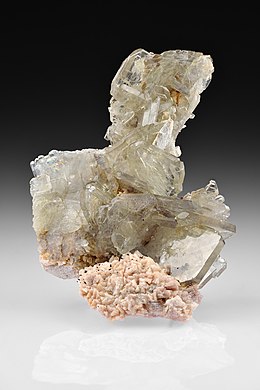| Baryte (barite) | |
|---|---|
 Baryte crystals from Cerro Huarihuyn, Miraflores, Huamalíes, Huánuco, Peru | |
| General | |
| Category | Sulfate mineral, barite group |
| Formula (repeating unit) | BaSO4 |
| IMA symbol | Brt[1] |
| Strunz classification | 7.AD.35 |
| Dana classification | 28.03.01.01 |
| Crystal system | Orthorhombic |
| Crystal class | Dipyramidal (mmm) H-M symbol: (2/m 2/m 2/m) |
| Space group | Pnma |
| Unit cell | a = 8.884(2) Å, b = 5.457(3) Å, c = 7.157(2) Å; Z = 4 |
| Identification | |
| Color | Colorless, white, light shades of blue, yellow, grey, brown |
| Crystal habit | Tabular parallel to base, fibrous, nodular to massive |
| Cleavage | Perfect cleavage parallel to base and prism faces: {001} Perfect, {210} Perfect, {010} Imperfect |
| Fracture | Irregular/uneven |
| Tenacity | Brittle |
| Mohs scale hardness | 3–3.5 |
| Luster | Vitreous, pearly |
| Streak | White |
| Diaphaneity | transparent to opaque |
| Specific gravity | 4.3–5 |
| Density | 4.48 g/cm3[2] |
| Optical properties | biaxial positive |
| Refractive index | nα = 1.634–1.637 nβ = 1.636–1.638 nγ = 1.646–1.648 |
| Birefringence | 0.012 |
| Fusibility | 4, yellowish green barium flame |
| Diagnostic features | white color, high specific gravity, characteristic cleavage and crystals |
| Solubility | low |
| References | [3][4][5][6] |
Baryte, barite or barytes (/ˈbæraɪt, ˈbɛər-/ BARR-eyet, BAIR-[7] or /bəˈraɪtiːz/ bə-RYTE-eez[8]) is a mineral consisting of barium sulfate (BaSO4).[3] Baryte is generally white or colorless, and is the main source of the element barium. The baryte group consists of baryte, celestine (strontium sulfate), anglesite (lead sulfate), and anhydrite (calcium sulfate). Baryte and celestine form a solid solution (Ba,Sr)SO4.[2]
- ^ Warr, L.N. (2021). "IMA–CNMNC approved mineral symbols". Mineralogical Magazine. 85 (3): 291–320. Bibcode:2021MinM...85..291W. doi:10.1180/mgm.2021.43. S2CID 235729616.
- ^ a b Hanor, J. (2000). "Barite-celestine geochemistry and environments of formation". Reviews in Mineralogy. 40 (1). Washington, DC: Mineralogical Society of America: 193–275. Bibcode:2000RvMG...40..193H. doi:10.2138/rmg.2000.40.4. ISBN 0-939950-52-9.
- ^ a b Dana, James Dwight; Ford, William Ebenezer (1915). Dana's Manual of Mineralogy for the Student of Elementary Mineralogy, the Mining Engineer, the Geologist, the Prospector, the Collector, Etc (13 ed.). John Wiley & Sons, Inc. pp. 299–300.
- ^ Barite at Mindat
- ^ Webmineral data for barite
- ^ Baryte, Handbook of Mineralogy
- ^ "baryte". Lexico UK English Dictionary. Oxford University Press. Archived from the original on March 8, 2020.
- ^ "barytes". Merriam-Webster.com Dictionary. Merriam-Webster.